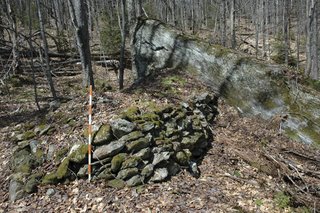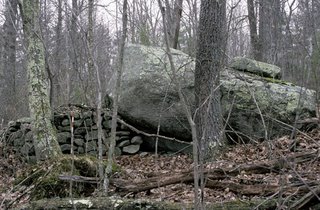There might be peculiar characteristics to certain boulders or cliffs that may evoke the image of an animal if seen in a certain light or at a particular angle. This is called simulacra. We may sometimes pass by something and say it looks like such-and-such animal, be it a turtle, bear, or whatever. To me, this is similar to a Rorshach test, in that everyone may see something different in a particular configuration of lines or forms, and because of this we must be careful in declaring that what we see, and what the ancients must have seen in the same boulder, must be a bear, for example. We do not know what the Indians saw in certain shapes, and if a shape evokes different responses in different people, we need to be careful what we say. If the form is very distinctive, however, as, for example, a clear turtle effigy that I was shown in Connecticut,
 we can be less hesitant in expressing our views. Two years ago when I was at a site in Rochester, VT, I passed by a large, unusual looking erratic that was tilted at an oblique angle. When viewed from the north, the boulder in profile looked to me like a huge turtle with its head and neck extended at a distinctive angle.
we can be less hesitant in expressing our views. Two years ago when I was at a site in Rochester, VT, I passed by a large, unusual looking erratic that was tilted at an oblique angle. When viewed from the north, the boulder in profile looked to me like a huge turtle with its head and neck extended at a distinctive angle. On the other side of the erratic was an unusual tongue-like stone construction, some 4m long, in which the carefully constructed vertical side to the right faced east.
On the other side of the erratic was an unusual tongue-like stone construction, some 4m long, in which the carefully constructed vertical side to the right faced east. Did the Indians also see a turtle in this boulder? Perhaps, but I really don’t know. I am pretty certain that the stone construction on one side was placed there because of the boulder’s unusual shape.
Did the Indians also see a turtle in this boulder? Perhaps, but I really don’t know. I am pretty certain that the stone construction on one side was placed there because of the boulder’s unusual shape.I know of two similar boulders with stone constructions at one end in Coventry, RI, one being a smaller version of the other. The larger boulder has a carefully piled stone construction to the left, which faces east, and on top to the right is a smaller flat boulder.
 And not more than thirty feet away is a smaller version of this erratic: a round boulder not more than 5’ high, a small curved pile of stones to the left, and a cluster of rocks on top, one of which is quartz.
And not more than thirty feet away is a smaller version of this erratic: a round boulder not more than 5’ high, a small curved pile of stones to the left, and a cluster of rocks on top, one of which is quartz. Four years ago I visited a friend in northwestern Georgia, who showed me a very extensive lithic site on one side of a mountain. About a mile to the south, on the same side of the mountain, was another area with additional cairns and terrace walls. Against one side of a very large boulder that had come loose from a high cliff in back and tumbled down the slope, was a carefully constructed terrace/wall..
Four years ago I visited a friend in northwestern Georgia, who showed me a very extensive lithic site on one side of a mountain. About a mile to the south, on the same side of the mountain, was another area with additional cairns and terrace walls. Against one side of a very large boulder that had come loose from a high cliff in back and tumbled down the slope, was a carefully constructed terrace/wall.. When I saw this for the first time, I was reminded of similar constructions in New England, and now, with other examples I know of, I am quite sure that this construction, as with the ones I have just illustrated, were all constructed because of the unusual shape and size of the boulder, in which an animal form was probably perceived.
When I saw this for the first time, I was reminded of similar constructions in New England, and now, with other examples I know of, I am quite sure that this construction, as with the ones I have just illustrated, were all constructed because of the unusual shape and size of the boulder, in which an animal form was probably perceived.
3 comments :
I read recently that a place could be special because of a plant that grew there.
Enjoyed this, Norman. You do a great job of explaining the subject clearly. Nice pictures.
I'm looking at material from different cultures concerning the meaning of boulders and stone or rock itself. I've posted a little on the blog linked at the side of this one, and will try to post more.
About four years ago I visited a vision quest site in Wisconsin called the Eagle's Nest, which consisted of a large, bowl-like depression excavated in dolomite on the edge of the Niagra Escarpment, a large bluff overlooking the Horicon Marsh, the largest fresh water marsh in the U.S. The depression was large enough to hold one person comfortably, and there was an unobstructed view facing west. Herman Bender wrote a report on the site, in which he said: "The view from the escarpment at the Eagle's Nest site overlooks a continental sub-divide where the waters flow either north through the Great Lakes or south to the Mississippi and the Gulf of Mexico. Here, there also are ancient red cedar trees growing on the edge of the escarpment; they may be upwards of a thousand years old. Red cedar trees are considered sacred by Native Americans of the mid and northern latitudes of North America."
Post a Comment